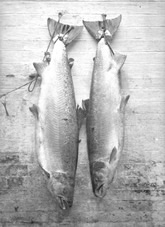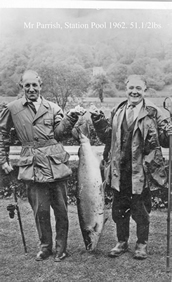In H A Gilbert's book "The tale of a Wye Fisherman" there is an interesting list of salmon weighing fifty pounds and over that were caught on the Wye up to October 1951.
| Year | Weight (lbs) | Angler | Water |
| 1914 | 51 | J Wyndham Smith | Aramstone |
 |
Picture by kind permission of George Woodward | ||
| 1920 | 52 | Col. Tilney | Higgins Wood |
| 1923 | 59.5 | Miss Doreen Davy (Mrs Pryce Jenkin) | Cowpond |
 |
Picture by kind permission of George Woodward | ||
| 1925 | 50 | Courtfield | |
| 1928 | 52.5 | The Hon. R Devereaux | The Nyth |
 |
Picture by kind permission of George Woodward | ||
| 1930 | 50 | Sir Thomas Merton | Castleton |
| 1930 | 50.5 | Col. Heywood | Caradoc |
| 1931 | 50 | Ivor Williams | Stowfield at Lidbrook |
 |
Picture by kind permission of George Woodward | ||
| 1935 | 50 | Captain Yates | Ballingham |
 |
Picture by kind permission of George Woodward | ||
| 1937 | 50.5 | Rocklands | |
| 1939 | 54 | Sir Thomas Merton | Cowpond | 1962 | 51.5 | Mr Parrish | Bigsweir - Station pool |  |
Picture by kind permission of George Woodward |
All of these fish were caught by spinning and according to records the largest salmon caught on the fly was a forty-three pounds (cock) caught on April 10th, 1915, at the Dog Hole (Goodrich Court), by C H Moffat. This does not necessarily imply that spinning will catch larger fish, but more likely that spinning was more predominant when the larger fish were more common in the Wye.
The largest Wye salmon that was landed was caught by Miss Doreen Davey, on March 13th, 1923, in the Cowpond, which is a pool on the Winforton stretch of the Wye. It took one hour and fifty-five minutes, eventually in darkness, to bring the fish into the bank and the succesful bait was a two-inch aluminium minnow made and supplied by Hattons of Hereford. Miss Davey had been fishing the fly all day but decided to change to a minnow, whilst waiting to be collected by her father.
There are records of other fish that were seen but unfortunately not landed, including the decomposed salmon which was washed up at Evenpitt Bridge at Holme Lacy and was etimated to be over 80lbs.
The larger salmon (40lbs plus) are caught on the Wye, in the spring, and no other time of the season. There is also a summer run of smaller fish and a grilse run. A grilse is a salmon that has been at sea for one winter and so these fish are relatively small. There are two genetic strains of salmon in the Wye that are known of; the indigenous Wye salmon and the ancestors of 700 young salmon from the Rhine that were introduced into the Wye by Frank Buckland in 1869. It is interesting to note that within four or five generations a change came over the river and the fish became larger and ran earlier. Could it be that the larger spring salmon run resulted from Frank Buckland's work?